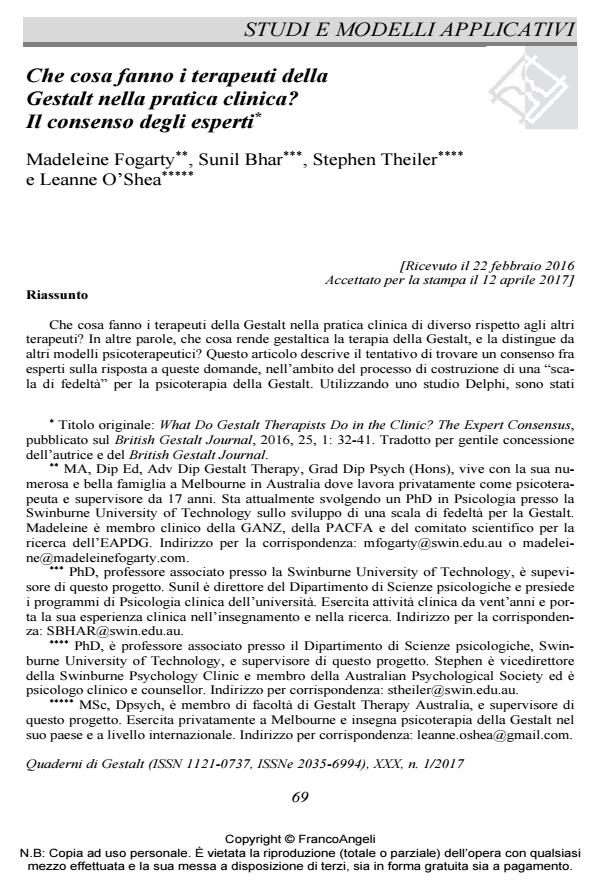Che cosa fanno i terapeuti della Gestalt nella pratica clinica? Il consenso degli esperti
Titolo Rivista QUADERNI DI GESTALT
Autori/Curatori Madeleine Fogarty, Sunil Bhar, Stephen Theiler, Leanne O’Shea
Anno di pubblicazione 2017 Fascicolo 2017/1 Lingua Italiano
Numero pagine 22 P. 69-90 Dimensione file 251 KB
DOI 10.3280/GEST2017-001006
Il DOI è il codice a barre della proprietà intellettuale: per saperne di più
clicca qui
Qui sotto puoi vedere in anteprima la prima pagina di questo articolo.
Se questo articolo ti interessa, lo puoi acquistare (e scaricare in formato pdf) seguendo le facili indicazioni per acquistare il download credit. Acquista Download Credits per scaricare questo Articolo in formato PDF

FrancoAngeli è membro della Publishers International Linking Association, Inc (PILA)associazione indipendente e non profit per facilitare (attraverso i servizi tecnologici implementati da CrossRef.org) l’accesso degli studiosi ai contenuti digitali nelle pubblicazioni professionali e scientifiche
Che cosa fanno i terapeuti della Gestalt nella pratica clinica di diverso rispetto agli altri terapeuti? In altre parole, che cosa rende gestaltica la terapia della Gestalt, e la distingue da altri modelli psicoterapeutici? Questo articolo descrive il tentativo di trovare un consenso fra esperti sulla risposta a queste domande, nell’ambito del processo di costruzione di una "scala di fedeltà" per la psicoterapia della Gestalt. Utilizzando uno studio Delphi, sono stati identificati otto concetti chiave che caratterizzano la terapia della Gestalt, e dei comportamenti del terapeuta che riflettono tali concetti.;
Keywords:Gestalt, scala di fedeltà, studio Delphi, accrescere la consapevolezza, lavoro relazionale, lavoro nel qui e ora, pratica fenomenologica, lavoro con la consapevolezza corporea (embodiment), pratica sensibile al campo, processi di contatto, atteggiamento sperimentale.
- Frew J. (2013). Gestalt Therapy Training and Research: Holding Our Place at Academic Institutions in the USA. Gestalt Review, 17, 3: 263-271.
- Barber J.P. (2009). Toward a Working Through of Some Core Conflicts in Psychotherapy Research. Psychotherapy Research, 19: 1-12. DOI: 10.1080/10503300802609680
- Brownell P. (2008). Handbook for Theory, Research, and Practice in Gestalt Therapy. Newcastle, UK: Cambridge Scholars Publishing.
- Brownell P. (2014). C’mon Now: Let’s Get Serious about Research. Gestalt Review, 18, 1: 6-23.
- Burley T. (2014). Can We Get Back to Being Serious about the Processes of Experience, Awareness, and the Action of Gestalt Formation Resolution? Gestalt Review, 18, 1: 17-21.
- Carley S., Shacklady J., Driscoll P., Kilroy D., Davis M. (2006). Exposure or Expert? Setting Standards for Postgraduate Education Through a Delphi Technique. Emergency Medicine Journal, 23: 672-4.
- Clayton M.J. (1997). Delphi: A Technique to Harness Expert Opinion for Critical Decision-Making Tasks in Education. Educational Psychology, 17: 373-86.
- de Villiers M.R., de Villiers P.J, Kent A.P. (2005). The Delphi Technique in Health Sciences Education Research. Medical Teaching, 27: 639-643. DOI: 10.1080/1361126050006994
- Falzon C., Sabiston C., Bergamaschi A., Corrion K., Chalabaev A., D’Arripe-Longueville F. (2014). Development and Validation of the Cancer Exercise Stereotypes Scale. Journal of Psychosocial Oncology, 32, 6: 708-726. DOI: 10.1080/07347332.2014.955237
- Fogarty M., Bhar S., Theiler S. (2015). Creating a Fidelity Scale for Gestalt Therapy. Gestalt Journal of Australia and New Zealand, 11, 2: 39-54.
- Gold E., Zahm S. (2008). The Need for Gestalt Therapy Research. In: Brownell P., ed., Handbook for Theory, Research, and Practice in Gestalt Therapy. Newcastle, UK: Cambridge Scholars Publishing, pp. 27-36.
- Hart L.M., Jorm A.F., Paxton S.J., Kelly C.M., Kitchener B.A. (2009). First Aid for Eating Disorders. Eating Disorders, 17, 5: 357-384. DOI: 10.1080/10640260903210156
- Linstone H.A., Turoff M. (1975). The Delphi Method Techniques and Applications. Boston, MA: Addison-Wesley.
- Mann D. (2010). Gestalt Therapy: 100 Key Points and Techniques. London-New York: Routledge.
- McConville M. (2014). Commentary 1: Gestalt Therapy, Research and Phenomenology. Gestalt Review, 18, 1: 23-31.
- O’Leary E., ed. (2013). Gestalt Therapy Around the World. Chichester, UK: Wiley-Blackwell.
- Parlett M. (2007). Response to the Festschrift. British Gestalt Journal, 16, 1: 53-56.
- Perepletchikova F. (2011). On the Topic of Treatment Integrity. Clinical Psychology: Science and Practice, 18: 148-153.
- Perls F.S., Hefferline R.F., Goodman P. (1951). Gestalt Therapy: Excitement and Growth in the Human Personality. Highland, NY: The Gestalt Journal Press (trad. it.: Teoria e pratica della terapia della Gestalt: vitalità e accrescimento della personalità umana. Roma: Astrolabio, 1997).
- Waltz J., Addis M.E., Koerner K., Jacobson N.S. (1993). Testing the Integrity of a Psycho-therapy Protocol: Assessment of Adherence and Competence. Journal of Consulting and Clinical Psychology, 61: 620-630.
- Wollants G. (2008). Gestalt Therapy: Therapy of the Situation. Turnhout, Belgium: Faculteit voor Mens en Samenleving.
- Yontef G., Jacobs L. (2013). Gestalt Therapy. In: Wedding D., Corsini R., eds., Current Psychotherapies. Belmont, CA: Brooks/Cole, pp. 299-336.
Madeleine Fogarty, Sunil Bhar, Stephen Theiler, Leanne O’Shea, Che cosa fanno i terapeuti della Gestalt nella pratica clinica? Il consenso degli esperti in "QUADERNI DI GESTALT" 1/2017, pp 69-90, DOI: 10.3280/GEST2017-001006